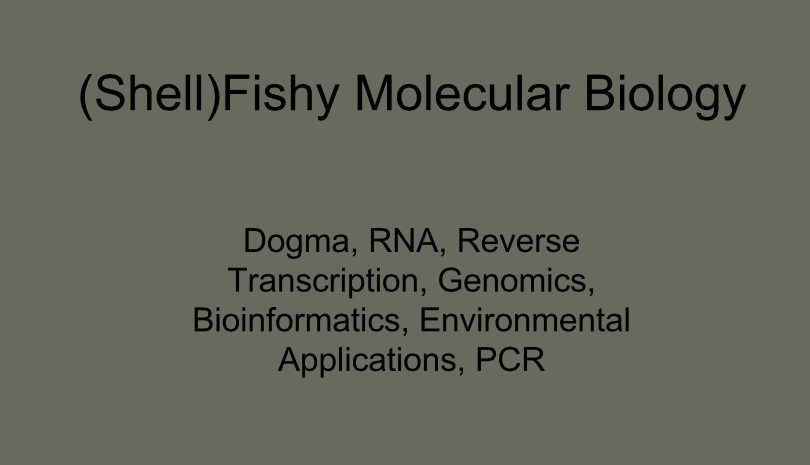This wiki serves as the platform for the lab section of the course Environmental Physiology.
Tuesdays: 1:30-4:20 FTR 113
During the first half of the quarter students will be exposed to various molecular techniques commonly used to study the response of an organism to changing environments. Some of these techniques may include tissue sampling, protein analysis, DNA methylation, and gene expression. During the second half of the quarter students will carryout independent projects that they will present in symposium format at the end of the quarter.
Lab Materials
Please print the linked lab materials before each lab.
- Lab 1 (introduction, pipettors, tissue)
- Lab 2 (RNA Isolation)
- Lab 3 (RT, PCR, Protein)
- Lab 4 (Protein Gel / Western)
Lab Notebooks
Lab Expectations
A notebook entry that includes the following components will be required for each lab and is DUE by 8 PM the Sunday after lab. A record of your lab work will be a very important reference as you embark on independent projects.
What should you include in your lab notebook?
Your lab notebook is a record of the procedures you perform and the results you obtain in lab. It should be detailed enough to allow you, or someone else, to repeat the experiment at a later time. Feel free to take a look at the lab notebooks of other students in the navigation box on the left. Let the TA know if you have any questions before lab notebooks are due. Minimally, your notebook entries should include:
- Dates
Your most recent entry should go at the top of your lab notebook. - Summary of the lab
In this section, record a summary of what you did in the lab that day.
You may consider including the following:
What was the purpose of the lab?
What were the techniques used?
What samples did you work with?
This section should be no more than a few sentences long. An example summary section might procede like this: "Protein was isolated from sockeye salmon brain tissue. The concentration of total protein in the tissue was determined using the Bradford protein assay. - Materials and Methods
Provide a concise description of methods used, but please do not cut and paste from the lab instructions.
List the samples used and your labeling scheme. One of the easiest mistakes made is forgetting how you labeled your tubes.
Record ALL MEASUREMENTS.
Make notes of OBSERVATIONS and DEVIATIONS from the procedure.
Include any calculations used to obtain results.
If primers were used, record the primer info such as primer sequences, amplicon size, G/C content, and melting temperature (Tm) - Results
Record the results of all analyses, even if they were not the expected results.
Include any images, such as gel photos, generated in lab with a caption explaining the image. - Conclusions
This is the section where you reflect on your results. A few things to consider are:
Are your results what you expected? Why or why not?
Based on your results, what are you going to do next?
Reflection (Yes, this is a REQUIRED section)
What do you think the purpose of this lab was?
What are the procedures performed in lab used to measure?
What kind of study might these these methods be used for?
What is unclear to you about the procedure used?
What do you wish there was more information on?
LAB NOTEBOOK ENTRIES ARE DUE WITHIN 5 DAYS (SUNDAY BY 8 PM) OF PERFORMING THE PROCEDURE. Lab Notebook entries are worth 27% of your total grade (9 entries - 3% each). There will be a 10% deduction for each day late.
Molecular Biology and Molecular Techniques Resources (video click below)
